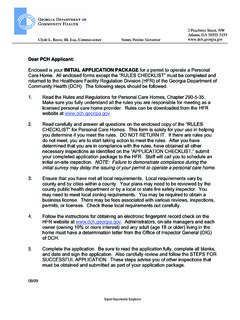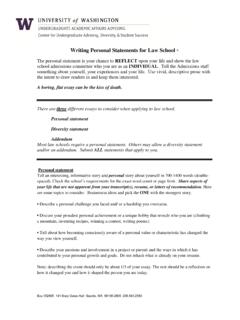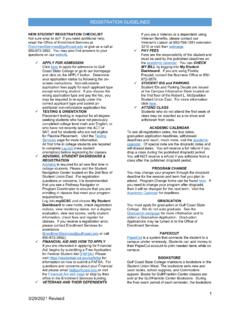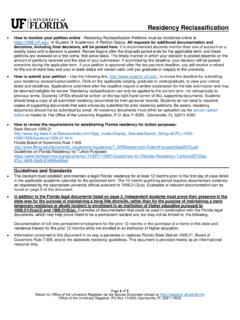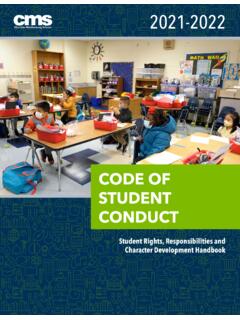Transcription of C. SOCIAL CLUBS - IRC 501(c)(7) by Jim Langley and Conrad ...
1 C. SOCIAL CLUBS - IRC 501(c)(7) by Jim Langley and Conrad Rosenberg 1. IntroductionSocial CLUBS are exempt from federal income tax under IRC 501(a) as organizations described in IRC 501(c)(7) if they are "organized for pleasure, recreation, and other nonprofitable purposes." They were originally granted exemption from federal income tax in the Revenue Act of 1916. Generally, SOCIAL CLUBS are membership organizations primarily supported by dues, fees, charges or other funds paid by their members. The central purpose of SOCIAL CLUBS is to provide benefits to members, including access to SOCIAL and recreational facilities such as club houses, golf courses, and swimming pools. When such benefits are funded by members, exemption has been justified by Congress on the theory that the members will be in the same position as if they had paid for the benefits directly.
2 The practical effect of the exemption is to allow individuals to join together to provide themselves with recreational or SOCIAL opportunities on a mutual basis without further tax consequences. The individual member is in substantially the same position as if he or she had spent his or her after-tax income on pleasure or recreation without the intervening organization. Consequently, the exemption for SOCIAL CLUBS operates properly only if the club's income is derived exclusively from members. For many years, however, income derived by CLUBS from outside of their membership ( , investment income), operated to subsidize the recreational facilities or activities for the members with revenue that was taxed neither to the members nor to the club.
3 To prevent club members from receiving benefits not contemplated by IRC 501(c)(7), Congress extended the unrelated business income tax to SOCIAL CLUBS in the 1969 Tax Reform Act. In doing so, however, Congress decided that, unlike most other types of exempt organizations, which were exempted because they provide some sort of community service or public benefit, CLUBS should be taxed on all income derived from outside their membership, including investment income. Special rules were provided for nonrecognition of gain from certain sales of club property when the proceeds are reinvested by the club for exempt purposes. The enactment of IRC 512(a)(3) in 1969 created an almost unique status for SOCIAL CLUBS in that they alone among exempt organizations are taxed on passive income (dividends, rents, and interest).
4 (Although the terms of IRC 512(a)(3) also apply to organizations described in paragraphs (9), (17) and (20) of IRC 501(c), the nature of these organizations, plus special rules in IRC 512(a)(3) relating to set-asides for charitable and similar purposes, virtually negate the tax theoretically imposed on them by IRC 512(a)(3).) Congress amended IRC 501(c)(7) in 1976 to liberalize prior Service limitations on the portion of income SOCIAL CLUBS could receive from nonmember use of their facilities and from investment income without jeopardizing their exempt status. The legislation changed the statutory test for exemption from an exclusivity test ("..operated exclusively for [exempt purposes]..") to a substantiality test (".)
5 Substantially all the activities of which are for [exempt purposes].."). The legislative history of the amendment indicates that Congress did not intend to modify the longstanding Service position that exempt SOCIAL CLUBS could not retain exempt status if they received even insubstantial amounts of income from activities not traditionally carried on by CLUBS in furtherance of their exempt purposes. Regulations to accompany this enactment have never been issued. The purpose of this article is to supplement and update previous CPE articles (particularly the 1992 text at p. 113, and the 1993 text at page 73) concerning SOCIAL CLUBS described in IRC 501(c)(7). Section 2 will re-visit the concepts of "traditional" and "nontraditional" activities with respect to SOCIAL CLUBS and the effect the distinction may have on the exempt status of a club.
6 Sections 3 and 4 will examine specific issues regarding timber and advertising sales of SOCIAL CLUBS . Section 5 will discuss the nondiscrimination requirement applicable to SOCIAL CLUBS under IRC 501(i). 2. Traditional vs. Nontraditional Activities 39115 (January 12, 1984), as modified by 39412 (September 19, 1985), discusses a SOCIAL club that conducted some permitted traditional business activities as well as prohibited nontraditional business activities. The principles set forth in 39115 and the current Service position with respect to nontraditional business activities of SOCIAL CLUBS may be illustrated by the following hypothetical: FACTS Situation 1: Club A was organized for SOCIAL and recreational purposes.
7 It owns a multi-story building located in a major urban center in which it provides athletic facilities, dining rooms, meeting rooms, and libraries for its members and their guests. The building also contains a large number of hotel-style rooms that are rented to members who stay in town after an evening attending club functions. However, at least 10 percent of the rooms are rented to members for use as their principal residence. In addition, because parking in the surrounding area is scarce, a parking garage and gas station are located in the basement. The parking garage is provided for a fee to members attending club functions and to members for monthly parking while at work. The gas station provides typical gas station services for typical gas station prices.
8 The lobby of the building contains a number of stores including a barber shop, flower shop, and liquor store. Access to all club facilities is restricted to members and their guests. Income from each of the gas station, liquor store, flower shop, barber shop, long term room rental, and commuter use of the parking facilities constitutes a substantial part of Club A's gross receipts for the taxable year. Situation 2: Club B was also organized for SOCIAL and recreational purposes. It operates a restaurant and bar, golf course, swimming pool, and tennis courts. In addition, it provides a take-out service which furnishes food and beverages to members for personal consumption away from the club facility, and a catering service for special events as requested by members.
9 Access to all club facilities is restricted to members and their guests. Income from the takeout and catering services combined constitutes less than five percent of B's gross receipts for the taxable year. LAW AND ANALYSIS IRC 501(c)(7) (prior to its amendment in 1976 by P. L. 94-568, 1976-2 596) provided for exemption from federal income tax of SOCIAL CLUBS organized and operated exclusively for pleasure, recreation, and other nonprofitable purposes, no part of the net earnings of which inures to the benefit of any private shareholder. P. L. 91-172, 1969-3 10, amended IRC 511 in 1969 to extend the unrelated business income tax provisions to all exempt organizations, including SOCIAL CLUBS described in section 501(c)(7).
10 It also added IRC 512(a)(3). IRC 512(a)(3)(A), in relevant part, provides that for certain organizations, including those described in IRC 501(c)(7), the term "unrelated business taxable income" means, in part, the gross income (excluding any exempt function income), less the allowable deductions directly connected with the production of the gross income (excluding exempt function income). IRC 512(a)(3)(B) provides that, for purposes of IRC 512(a)(3)(A), the term "exempt function income" means the gross income from dues, fees, charges, or other similar amounts paid by members of the organization as consideration for providing such members or their dependents or guests goods, facilities, or services in furtherance of the purposes constituting the basis for the exemption of the organization to which such income is paid.











